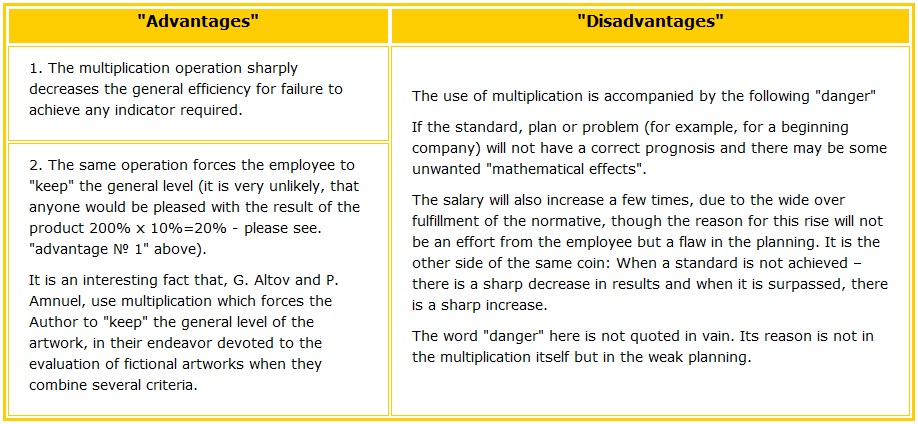ADVANTAGES AND DISADVANTAGES OF MULTIPLICATION
It is often said that: "I shall pay on end result!.." And just as often we get puzzled with: "Yes, but there are many of them (the results)…" What should we do?
Consider each one? How to "tie" each to one salary then. Outline the "main rating" from several? Which sign should be put between them?
And later. When there are the result criteria of several individuals, how shall we not allow each one to "dissolve" in this "general evaluation" and how shall we NOT "pick" one instead of the other? How shall we not let the opportunity pass, when the employee goes on "retirement" when a big deal is "struck"?
What shall force the employee to constantly "keep" a good level? And what shall be done when the employee "stopped short", and he feels that the punishment is too severe?
This is what Alevtina Kavtreva and Ksenia Tkalich will discuss about.
PART 1
"SIGNS"
K. Tkalich: So let’s re-read the announcement in the article and begin to answer …
A. Kavtreva: Let me remind you: we already had such a problem once. In order to evaluate not only luck but also effort, 2 categories were offered to be used to calculate the bonus of salespeople in the "Article about salary": "Efficiency on turnover" and "Efficiency on the number of sales" (because in a shop not only the trade of expensive products is important (carpets, projector televisions etc.), but also the sales of simple ones (cheap wallpapers, coffee grinders, kettles, etc.).
In order to correlate two criteria into one General Efficiency, we used MULTIPLICATION:

K. Tkalich: And once more, we shall ask: can we remove this "negative" effect from multiplying (see the "disadvantages" above), if the company is growing and at some point it is difficult to accurately set standards?
I shall note that an arithmetical mean does not have this shortcoming. It gives, as we saw earlier, "it gives a smoother feedback" if the task is not completed on one indicator. Which means, even sharp raises for over fulfillment of plans or, on the contrary, its collapse, there will be – neither "advantages" nor "disadvantages".
A. Kavtreva: However this "virtue" of the arithmetical mean is also it's shortcoming. We can "concentrate" on one of the criteria and relax over the same "smooth" ("arithmetical mean") calculation.
K. Tkalich: And what can we do?
PART 2
"THRESHOLDS"
A. Kavtreva: The way out of this situation is described above – by introducing minimum efficiency.
Minimum ("threshold") Efficiency – it is the last value of efficiency, below which begin "indecent values".
In the "Article about salary" it is recommended to set the minimum Efficiency at ~ 70% or more (but certainly not less). For efficiency lower than the threshold value, the work is considered as indecently bad.
K. Tkalich: Counter question: what if the employee does not reach the "borderline" of minimum efficiency, shall he be left without bonus?
A. Kavtreva: In some situations – yes, and in some – no.
Let’s compare 2 situations:
SITUATION 1
1.1. Let’s suppose the basic (base) PART of the salary of an employee is - 8 000 tugriks, and the planned bonus (variable) part is – 2 000 tugriks.
Note.. When we say “planned”, we mean that part, which will be paid for a 100% efficiency.
1.2. One of some indicators has not reached the threshold value.
For such a correlation (see clause 1.1.) the variable part shall not be paid.
SITUATION 2
2.1. The constant part of the employee is - 2 000 tugriks, а
and the bonus part is – 8 000 tugriks.2.2. One or more indicators have not crossed the threshold value.
Not paying the variable part n this situation would be too strict punishment. The employee will have nothing to live on.
SOLUTION
For such a correlation (see clause 2.1.) the general Efficiency is equated to the lowest value.Let s illustrate what we said.
1. Let s suppose that the employee has two result criteria, for which, in the current month he reached the following results:
Then the General Efficiency = the lowest indicator, that is 65%2.
2. If the Efficiency for both indicators was higher than the minimum value, the general efficiency would be calculated through "arithmetical mean".
For EXAMPLE:
- Efficiency on turnover = 84%, а
- Efficiency on the number of Clients = 110%.
Then the General Efficiency = (Efficiency on turnover + Efficiency on the number of Clients)/2, т.е. 97%.
That is how we solve the problem.
K. Tkalich: But this is only true for such a situation when the result criteria are of equal value. What if they are not? What should we do if one of the result criteria is more important than the other? Or for EXAMPLE, the employee has more influence on it?
PART 3
"WEIGHT"
A. Kavtreva: Then for each result criteria we shall introduce a "weight coefficient". The formula looks like this:
|
General Efficiency= "Weight" (value) of the 1st criteria * 1st result criteria+ "Weight" 2nd criteria * 2nd result criteria |
I shall give an EXAMPLE.
In some company, the manager sells goods, with a price distribution ranging from USD 2 500 to USD 3 200 for a unit. But the growth in turnover is reached due to the increase in the number of sales. That is why, the meaning of the number of sales, in this case, is higher (let’s compare the number of sales to turnover - 70:30). Then the general result will be calculated as follows:
|
General Efficiency = 70% * Efficiency on number of sales + 30% * Efficiency on turnover |
This is nothing like "average" Efficiency, and what is interesting is that:
- When the "weight" of the criteria is significant (70%, 80% or 90%), we have the same unwanted consequences as for multiplication (see PART 1. "Signs").
- When the "weight" is lower or near 50% (in essence - it is the same "average"), "the disadvantages" are the same as for the "arithmetical mean".
Of course, when calculating the "average weight" the same minimum efficiency should be used. That is, follow the steps described in part 2 "Threshold".
K. Tkalich: I have such a question: What shall we do if the "weight" of the criteria is very low, and the minimum Efficiency was not reached for those criteria?
A. Kavtreva: Let me give an EXAMPLE. In some companies, there are small delays in payment from the Clients. They do not create many problems, but we do not want bad traditions to develop. As a prophylactic measure, an Efficiency on accounts receivable turnover, is introduced in the salary of managers which has a low "weight'. The introduction of such an indicator has more of a reminding role.
In this case, we can agree that the General Efficiency will not equate to the "worst" (lowest) indicator if the minimum Efficiency IS NOT REACHED in a criterion with low "weight".
Let’s illustrate what we said.
EXAMPLE
The employee has two result criteria - R1 и R2.
Let’s suppose: the General Efficiency = 90% * R 1+10%* R 2 (that is the "weight" of R1 is high, and that of R2 – is low).
If an indicator with a high "weight" R1 does not reach the minimum efficiency of 70% (for EXAMPLE, it will be R1=68%), and everything will be fine with R2 (the indicator with low "weight (R2 = 100%), then we can equate the general Efficiency to the "worst" value.
That is, in this situation the General Efficiency = 68%.
f the SITUATION will be opposite (R1=100%, and R2=68%), that is the minimum efficiency does not reach the indicator with low "weight", then the calculation for "average weight" is done using the formula:
General Efficiency= 90% *Р1+10%*Р2=90%*100%+10%*68%= 97%.
K. Tkalich: I have the following question: is not a weak punishment for a low value of R2?
A. Kavtreva: If such a problem crops up, we shall increase the "weight" of this indicator.
PART 4
"STEPS"
K. Tkalich: It is often asked: "Can a progressive system of salary solve the same problems as in multiplication or high "weight"?
A. Kavtreva: "Progressive system" (as the people call it) is applied in order to increase the "sensitivity" to perform each percentage of the plan. Because often employees, reaching a certain result, believe that it "is already enough", relax and do not tend to do more.
K. Tkalich: Yes, and for a progressive system of salary, the higher the Efficiency, the "more expensive" each percentage gets. That is why, it is considered that the interest in results increases.
A. Kavtreva: But actually, people often refuse "progressive system".
K. Tkalich: I wonder why?
A. Kavtreva: For a few reasons.
1. It is actually often not understood as a "rise in the price" of each percentage of fulfillment of the task (plan) but as a linear growth of awards in percentages from profit or turnover. Many employers do not wish calculate awards from these indicators.
Note. See more details about this in the article "9 don’ts".
Furthermore, in this case only one criterion stimulates, but several are actually needed. What is our article about?
2. As a fact, very often "luck" is paid for (from the phrase "got lucky!"): Any very big order brings in not only a high but a very high salary.
3. Most importantly, "progressive system" is not liked because it does not stimulate "averagers" at all (to whom in the beginning was aimed the chapter "The Stimulation of Angels and not people"). The best employees – yes, they can be touched. Actually only their results fall into this range where stimulation is strengthened. However, "progressive system" was not meant for the best employees.
4. And let’s add one more weighty reason – it is the acute increase in the difference between the sizes of salaries in cases of collapse and in cases of growth; During big workloads and during forced downtimes.
"Progressive system" (in essence) – is the same multiplication but only "one-sided".
K. Tkalich: What does "one-sided multiplication" mean?
A. Kavtreva: "Multiplication" of the result criteria, as opposed to "progressive system", solves some problems in different criteria at the same time. Not only "luck" but most importantly "effort" is also awarded (as a matter of fact, reaching good results in all the given criteria is not the same thing as reaching only one of them).
K. Tkalich: A progressive-regressive salary (if we are talking about "rises in prices" of each percentage in fulfilling the plan) has one advantage over the use of multiplication for a variety of result criteria: rise and fall of awards can be made less "acute".
A. Kavtreva: Here you should pay attention to the following. The results of formula and multiplication "suffer" from acute rise even with a weight coefficient. To some extent, this is payback for the desire to increase the "sensitivity", to make an employee "hold out" every percentage of the plan.
K. Tkalich: And sometimes, those for whom "an acute rise" was coined, begin to "practice deceit" by "throwing" the results on someone specific for the "best" to earn much and then "share" with the others or "concentrate" the results within one reported month, not "showing" the "earnings" of the precedent period.
Though, this may happen for any system which strengthens the interest of the employee.
A. Kavtreva: Yes, but such "throws" are not so terrible. This problem can be solved.
K. Tkalich: I would just want to know, how?
A. Kavtreva:
- By implementing a normal system of control and report;
- By implementing "counterweights" (if there is a supposed raise in salary for results, there should also be a fall of salary if the results are absent);
- It often helps to introduce a quarterly bonus for "stable high Efficiency". If an employee has an average Efficiency for a quarter lower than for example 90%, then the special bonus is not paid.
- Another solution is the introduction of a category of employees. The category depends on the quarterly (or semiannual) efficiency and defines the basic part, from which the whole calculation for salary is made.
Once in a quarter (or semiannually) the category is revised according to the results of the work and evaluation. The employee "who throws" Clients, risks to lower his category. This leads to a decrease in the constant part (basic) salary (on the long run) and with it, the variable part (which is calculated as a part of the basic salary).
K. Tkalich: As a conclusion – a funny question: Which other arithmetic actions can be taken? For EXAMPLE, why not try logarithm?
A. Kavtreva: The general rules are as follows: In a salary model it is better to use only criteria which are understandable by the employee and arithmetical actions. The main principle of a workable salary – is its "transparency".
…Remember the "exotic" situation, when during the development of salary for his department (chemical-technological) a director, analyzed all the possible arithmetic actions and chose… "An average geometrical solution". "Any technologist understands this term, - he explained. – And even solve harder problems…".
The Authors thank Sergey Sychev and Galina Bladimirova (“TRIZ-CHANCE” system) for their help in working this article.
1 Efficiency= (Actual value / standard value) х 100%
2 Sometimes it makes sense in "non-season periods" to decrease the threshold of minimum efficiency, and in "peak" periods to increase.










